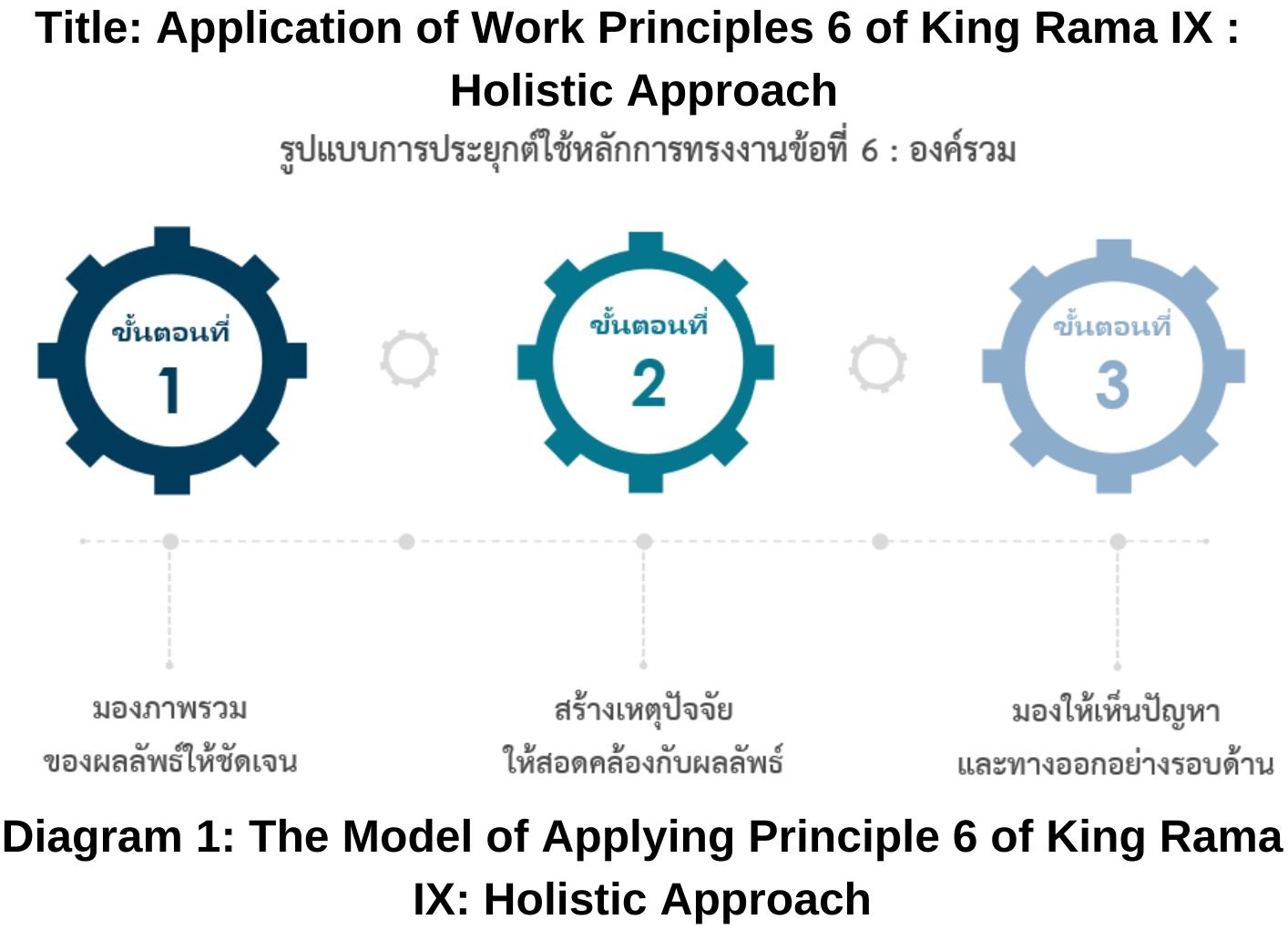Application of Work Principles 6 of King Rama IX : Holism
Keywords:
Application, Work Principles 6 of King Rama IX, HolismAbstract
This academic article aims to study the application of the 6th principle of His Majesty's working principles, which is "Holistic Approach." The analysis results show that the application of this principle can be implemented in the following ways: 1) Clearly envision the overall outcome: Start by thoroughly analyzing the problem, set clear and comprehensive goals covering all relevant dimensions, and assess both positive and negative impacts to prepare for potential prevention or resolution of issues. Collect and analyze data from all perspectives using diverse and comprehensive sources such as statistical data, expert opinions, and public opinions. The detailed analysis is intended to provide a holistic view of the problem and the solution approaches. Plan the operations comprehensively, covering all steps and relevant factors, and establish systematic implementation and monitoring guidelines to enable appropriate adjustments and corrections. 2) Align factors with the desired outcomes: This involves recognizing the interrelated components that either contribute to achieving goals or cause problems, as well as the impacts arising from certain decisions. It is about considering all relevant aspects comprehensively to facilitate problem-solving or goal achievement using methods appropriate to the current situation. 3) Identify problems and solutions comprehensively: This means recognizing potential problems and obstacles or those that are likely to arise. Before commencing operations, it is essential to analyze the risks and obstacles that may occur in all dimensions.
References
การศาสนา, กรม. (2525). พระไตรปิฎกภาษาไทย ฉบับหลวง. กรุงเทพฯ : กรมการศาสนา.
ชัยโรจน์ นพเฉลิมโรจน์. (2565). การคิดนวัตกรรมด้วยหลักการทรงงานตามหลักปรัชญาหลังนวยุค. วารสารการวิจัยเพื่อพัฒนาชุมชน, 15(2), 111-117.
ชัยโรจน์ นพเฉลิมโรจน์. (2565). องค์รวม : การศึกษาเชิงวิเคราะห์ วิจักษ์ และวิธาน. วารสารวิจัยธรรมศึกษา, 5(2), 222-230.
ชัยโรจน์ นพเฉลิมโรจน์. (2567ก). การประยุกต์ใช้หลักการทรงงานข้อที่ 1 : ศึกษาข้อมูลอย่างเป็นระบบ. วารสารสถาบันพอดี, 1(1), 38-53.
ชัยโรจน์ นพเฉลิมโรจน์. (2567ข). การประยุกต์ใช้หลักการทรงงานข้อที่ 2 : ระเบิดจากข้างใน. วารสารสถาบันพอดี, 1(2), 46-60.
ชัยโรจน์ นพเฉลิมโรจน์. (2567ค). การประยุกต์ใช้หลักการทรงงานข้อที่ 3 : แก้ปัญหาที่จุดเล็ก. วารสารสถาบันพอดี, 1(3), 33-40.
ชัยโรจน์ นพเฉลิมโรจน์. (2567ง). การประยุกต์ใช้หลักการทรงงานข้อที่ 4 : ทำตามลำดับขั้น. วารสารสถาบันพอดี, 1(4), 33-44.
ชัยโรจน์ นพเฉลิมโรจน์. (2567จ). การประยุกต์ใช้หลักการทรงงานข้อที่ 5 : ภูมิสังคม. วารสารสถาบันพอดี, 1(5), 30-40.
เมธา หริมเทพาธิป. (2559). การศึกษาตามหลักปรัชญาหลังนวยุคนิยมสายกลาง : วิเคราะห์จากหลักการทรงงานของพระบาทสมเด็จพระปรมินทรภูมิพลอดุลเดช. วารสารศึกษาศาสตร์ มมร, 4(1), 120-132.
วิลาศ เตชะไพบูลย์. (2567). สถาบันนโยบายศึกษา. สังคมไทยแบบองค์รวมกับองค์รวมแบบไทยๆ. [ออนไลน์]. แหล่งที่มา : https://www.fpps.or.th/news.php?detail=n1024512798.news [7 มิถุนายน 2567]
วีระ สมบูรณ์. (2547). คลังข้อมูลและความรู้ระบบสุขภาพ สถาบันวิจัยระบบสาธารณสุข (สวรส.). แบบแผนและความหมายแห่งองค์รวม. [ออนไลน์]. แหล่งที่มา : https://kb.hsri.or.th/dspace/handle/11228/1594?locale-attribute=th [7 มิถุนายน 2567]
ศรุตปุณธนัชญ์ ปูไลอารีย์, จสต. (2567). การบริหารที่เป็นองค์รวม. [ออนไลน์]. แหล่งที่มา : http://www.wdoae.doae.go.th/wp2018/wp-content/uploads/2021/ [7 มิถุนายน 2567]
สำนักงานคณะกรรมการพิเศษเพื่อประสานงานโครงการอันเนื่องมาจากพระราชดำริ (สำนักงาน กปร.). (2559). หลักการทรงงานในพระบาทสมเด็จพระเจ้าอยู่หัว. (พิมพ์ครั้งที่ 11). กรุงเทพฯ : สำนักงาน กปร.

Downloads
Published
How to Cite
Issue
Section
License
Copyright (c) 2024 Institute of Sufficiency Journal

This work is licensed under a Creative Commons Attribution-NonCommercial-NoDerivatives 4.0 International License.



